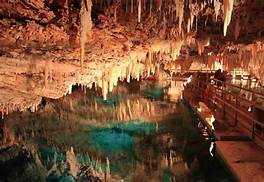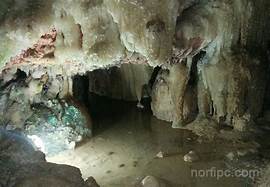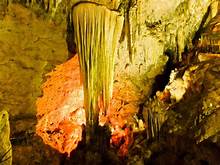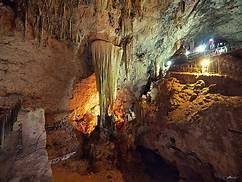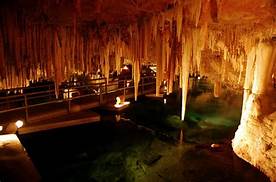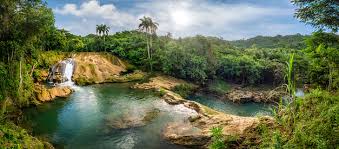EL SISTEMA cavernario que circunda la ciudad de Matanzas está formado por grutas que asumen disímiles características, van desde kilómetros de recorrido hasta pequeños agujeros angostos de difícil acceso para el hombre.
Estos accidentes geográficos en diferentes momentos sirvieron como refugio, primeramente al hombre primitivo y después a los mambises y rebeldes, quienes se resguardaron en su interior de la lluvia, el frío o el acecho enemigo. En ese sentido las espeluncas matanceras han desempeñado un importante papel dentro de la historiografía local.
LAS CUEVAS DE BELLAMAR Y SUS MISTERIOS…
Desciendes por las escaleras de mampostería, desgastadas por el agua y el tiempo y pareciera que nunca terminarán. Ciento cincuenta y nueve peldaños más abajo, después de sentir un considerable calor, aunque la temperatura promedio del año es de 26 grados Celsius, te recibe el Manto de Colón, una estalactita con 12 metros de altura y más de 30 siglos de vida.
En el Templo Gótico, el salón cuadricular de 80 metros de largo y 25 de ancho te da la bienvenida al lugar, exhibiendo algunas de sus más impresionantes formaciones rocosas: El Huerto de las Zanahorias, La Capilla de los Doce Apóstoles y Doña Mamerta.
Pero la cueva se extiende hacia el este y el oeste, con una longitud que sobrepasa las 780 hectáreas de extensión, con 23 kilómetros de túneles, y cámaras aún inundadas totalmente. Otras de sus cavidades son la Galería de los Dos Lagos, la de los Enanos, la de los Megalocnus y el Salón de las Esponjas, al este del Salón Gótico. En la otra dirección se encuentran el Pasadizo de Hatuey, el Salón de las Damas, el Lago de las Dalias y el Baño de la Americana.
Las Cuevas de Bellamar, ubicadas en lo más alto de una colina a unos cinco kilómetros del centro histórico de la ciudad, son famosas en el mundo por sus especiales formaciones, restos marinos estimados en más de 25 millones de años, su flora característica y sus leyendas.
Como un pacto de amor eterno bajan desde el techo de la cueva las estalactitas y las estalagmitas se dirigen presurosas al encuentro desde el piso, formando columnas. Estas caprichosas formaciones han tapizado la caverna, junto a las helictitas, todas recubiertas con una superficie cristalina, de aspecto transparente y brilloso.
Diseñado por la naturaleza y bautizado por el hombre, se hallan el Túnel del amor, la Capilla de los doce apóstoles, la Garganta del Diablo, el Paso de la Lluvia, el Salón de las Nieves y el Templo a San Pedro. Galerías horizontales y estrechas conforman los 9 niveles de la caverna matancera estudiados hasta el momento.
El carso, de aproximadamente 25 mil años de antigüedad, está compuesto en su mayoría por rocas caliza y marga, con un gran contenido de arcilla. Para los conocedores de la espeleología, las Cuevas de Bellamar son consideradas un laboratorio potencial destinado al estudio de la cristalografía subterránea, por encontrarse en sus galerías una amplia representación de formas cristalinas de singular belleza.
La antigüedad de sus formaciones permitió que sirvieran de refugio a la fauna cuaternaria de la región, hecho confirmado por el hallazgo en las excavaciones de restos de animales prehistóricos. Declaradas Monumento Nacional, figuran en la lista indicativa de las propuestas para optar por la categoría de Patrimonio de la Humanidad, por la mágica fascinación que atrae a turistas locales y forános.
Las Cuevas de Bellamar es una legendaria formación cavernaria que se incluye entre las exclusividades naturales de la provincia de Matanzas. Mezcla de historia, leyendas e indiscutibles valores, permanece incólume cual fiel testigo de los siglos. Un paraíso subterráneo que resalta por la autenticidad de sus formaciones cristalinas que retan la imaginación y a la propia naturaleza.
DATOS ADICIONALES
* Comenzó a formarse hace unos 300 mil años
* Fue descubierta, por casualidad, en febrero de 1861 al sur de la bahía de Matanzas.
* Cuentan que, previendo que se convirtiera en refugio de los cubanos insurrectos, la cueva estuvo cerrada por varios años, durante la Guerra de Independencia.
* Algunos investigadores plantean que la cueva era parte de la bahía de Matanzas pero que, a consecuencias de movimientos en las capas terrestres, esta zona emergió, formando las terrazas marinas que se notan en los terrenos en la ciudad de Matanzas y sus alrededores.
* El Baño de la Americana encierra una singular leyenda sobre una veraneante estadounidense que se perdió en ese sitio cuando decidió refrescar su cuerpo en las cristalinas y frías aguas. Sin embargo, el hecho no ha sido confirmado y desde entonces miles de personas han seguido bañándose.
* Muchos salones de la caverna quedan únicamente reservados para las labores científicas pues su acceso se torna en extremo difícil y requiere el uso de equipos especializados en la actividad.
* Cavernas difíciles: El gato jíbaro y El jarrito.
THE CAVES OF BELLAMAR AND THE UNDERGROUND SECRETS OF THE CAVE SYSTEM OF MATANZAS, CUBA. PHOTOS.
THE cave system that surrounds the city of Matanzas is made up of caves that assume dissimilar characteristics, ranging from kilometers of travel to small narrow holes that are difficult for a man to access.
These geographical features at different times served as a refuge, firstly for primitive man and later for the mambises and rebels, who sheltered inside from the rain, cold, or enemy stalking. In this sense, the espeluncas from Matanzas have played an important role in local historiography.
THE CAVES OF BELLAMAR AND ITS MYSTERIES…
You descend the masonry stairs, worn by water and time and it seems that they will never end. One hundred and fifty-nine steps below, after feeling a considerable heat, although the average temperature of the year is 26 degrees Celsius, you are greeted by the Manto de Colón, a stalactite 12 meters high and more than 30 centuries old.
In the Gothic Temple, the square hall 80 meters long and 25 wide welcomes you to the place, displaying some of its most impressive rock formations: The Carrot Garden, The Chapel of the Twelve Apostles, and Doña Mamerta.
But the cave extends to the east and west, with a length that exceeds 780 hectares, with 23 kilometers of tunnels, and chambers that are still completely flooded. Other of its cavities are the Gallery of the Two Lakes, that of the Dwarfs, that of the Megalocnus, and the Hall of the Sponges, to the east of the Gothic Hall. In the other direction is the Passage of Hatuey, the Hall of the Ladies, the Lake of the Dalias, and the Bath of the Americana.-
The Bellamar Caves, located at the top of a hill about five kilometers from the historic center of the city, are famous in the world for their special formations, marine remains estimated to be more than 25 million years old, their characteristic flora, and their legends.
Like a pact of eternal love, the stalactites and stalagmites descend from the ceiling of the cave, rushing to meet from the floor, forming columns. These capricious formations have covered the cavern, together with the helictites, all covered with a crystalline surface, with a transparent and shiny appearance.
Designed by nature and baptized by man, there is the Tunnel of Love, the Chapel of the Twelve Apostles, the Devil’s Throat, the Rain Pass, the Snow Hall, and the Temple of Saint Peter. Horizontal and narrow galleries make up the 9 levels of the Matanzas cave studied so far.
The karst, approximately 25,000 years old, is composed mostly of limestone and marl rocks, with high clay content. For connoisseurs of speleology, the Bellamar Caves are considered a potential laboratory for the study of underground crystallography, as a wide representation of crystalline forms of singular beauty can be found in its galleries.
The antiquity of its formations allowed it to serve as a refuge for the Quaternary fauna of the region, a fact confirmed by the discovery of the remains of prehistoric animals during excavations. Declared a National Monument, they appear on the indicative list of proposals to opt for the category of World Heritage, due to the magical fascination that attracts local and foreign tourists.
Las Cuevas de Bellamar is a legendary cave formation that is included among the natural exclusivities of the province of Matanzas. A mixture of history, legends, and indisputable values, it remains intact as a faithful witness of the centuries. An underground paradise that stands out for the authenticity of its crystalline formations that challenge the imagination and nature itself.
ADDITIONAL DATA
* Began to form about 300 thousand years ago
* It was discovered, by chance, in February 1861 south of Matanzas Bay.
* They say that anticipating that it would become a refuge for the insurgent Cubans, the cave was closed for several years, during the War of Independence.
* Some researchers suggest that the cave was part of the Bay of Matanzas but that, as a consequence of movements in the terrestrial layers, this area emerged, forming the marine terraces that can be seen on the land in the city of Matanzas and its surroundings.
* The Bath of the Americana contains a unique legend about an American vacationer who got lost in that place when she decided to refresh her body in the crystal clear and cold waters. However, the fact has not been confirmed and since then thousands of people have continued to bathe.
* Many rooms in the cave are only reserved for scientific work, as access becomes extremely difficult and requires the use of specialized equipment for the activity.
* Difficult caves: El gato jíbaro and El jarrito.
Agencies / CMGW / BellamarHist. / Extractos/ Excerpts/ Internet Photos / Arnoldo Varona / www.TheCubanHistory.com
THE CUBAN HISTORY, HOLLYWOOD.



 LAS CUEVAS DE BELLAMAR y los Secretos Subterraneos del Sistema Cavernario de Matanzas, Cuba. * THE CAVES of Bellamar, and the Underground Secrets of the Cave System of Matanzas, Cuba. PHOTOS.
LAS CUEVAS DE BELLAMAR y los Secretos Subterraneos del Sistema Cavernario de Matanzas, Cuba. * THE CAVES of Bellamar, and the Underground Secrets of the Cave System of Matanzas, Cuba. PHOTOS.